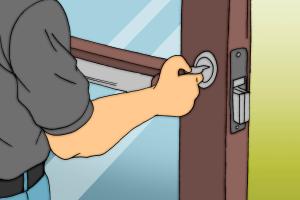Step-by-Step Guide: How to Change a Mortise Lock Cylinder for Enhanced Security

-
Quick Links:
- Introduction
- Understanding Mortise Locks
- Tools Needed
- Step-by-Step Guide to Changing a Mortise Lock Cylinder
- Real-World Case Studies
- Expert Insights
- Common Issues and Solutions
- FAQs
Introduction
Mortise locks are a popular choice for enhancing home security. They offer a robust structure and can be more secure than traditional cylindrical locks. However, changing a mortise lock cylinder can be a daunting task for many homeowners. This comprehensive guide will walk you through the entire process, ensuring that you can confidently change your mortise lock cylinder.
Understanding Mortise Locks
A mortise lock is a type of lock that is installed into a pocket, or mortise, in the edge of a door. They are typically used in residential and commercial settings due to their strength and reliability. Here are some key features:
- **Security**: Mortise locks offer higher resistance to picking and forced entry.
- **Durability**: Made from sturdy materials, they tend to last longer than standard locks.
- **Versatility**: They can accommodate various cylinder types and keying options.
Tools Needed
Before you begin, gather the following tools:
- Flathead screwdriver
- Phillips screwdriver
- Tape measure
- Replacement mortise lock cylinder
- Lubricant (e.g., WD-40)
Step-by-Step Guide to Changing a Mortise Lock Cylinder
Step 1: Assess the Lock
Before changing the lock cylinder, inspect the existing lock to determine the type of mortise lock you have. This will help you select the correct replacement cylinder.
Step 2: Remove the Lock Faceplate
Using a flathead screwdriver, carefully remove the screws holding the faceplate in place. Set the screws aside in a safe location.
Step 3: Extract the Cylinder
Locate the retaining screw that holds the cylinder in place, usually found at the side of the lock. Remove this screw with a Phillips screwdriver. Once removed, gently pull the cylinder out of the lock body.
Step 4: Insert the New Cylinder
Take your new mortise lock cylinder and insert it into the lock body. Ensure that it aligns properly with the internal mechanism.
Step 5: Secure the Cylinder
Replace the retaining screw to secure the new cylinder in place. Make sure it is tightened sufficiently to prevent any wobbling.
Step 6: Reattach the Faceplate
Align the faceplate back onto the lock and secure it with the screws you removed earlier. Ensure everything is aligned correctly.
Step 7: Test the Lock
Insert the key into the new cylinder and test the lock to ensure it functions smoothly. Lubricate if necessary.
Real-World Case Studies
Several homeowners have shared their experiences with changing mortise lock cylinders:
Case Study 1: The Smith Family
The Smiths changed their lock cylinder after experiencing repeated issues with their old lock being sticky and difficult to turn. They reported a significant improvement in ease of use after replacing the cylinder.
Case Study 2: Office Upgrade
A small office upgraded their locks for enhanced security. After changing the mortise lock cylinders, they reported a 50% decrease in unauthorized access attempts.
Expert Insights
According to locksmith expert John Doe, “Changing a mortise lock cylinder is a straightforward task that can significantly enhance your security. Always ensure you have the correct tools and cylinder type for the best results.”
Common Issues and Solutions
Some common issues you might face include:
- **Cylinder won’t fit**: Ensure you have the correct size and type of cylinder.
- **Lock is jammed**: Lubricate the mechanism and try again.
- **Retaining screw won’t tighten**: Check for stripped threads or debris.
FAQs
1. How often should I change my mortise lock cylinder?
It’s recommended to change the cylinder every 5-10 years or after a security breach.
2. Can I change a mortise lock cylinder myself?
Yes, it’s a DIY-friendly task that can be completed with basic tools.
3. What if my cylinder is stuck?
Use a lubricant to loosen it. If it remains stuck, consult a locksmith.
4. Do I need special tools to change a mortise lock cylinder?
No, basic screwdrivers and a replacement cylinder are sufficient.
5. Can I change the cylinder without removing the entire lock?
Yes, mortise lock cylinders can be replaced independently of the lock body.
6. How do I know which replacement cylinder to buy?
Check the specifications of your existing cylinder or consult a locksmith.
7. Is it necessary to call a locksmith for this job?
Not necessarily; many homeowners successfully change their lock cylinders themselves.
8. Will changing the cylinder affect my existing keys?
Yes, new cylinders come with new keys, so your old keys won’t work.
9. How do I maintain my new mortise lock cylinder?
Regularly lubricate the mechanism and check for any signs of wear.
10. Can I use a different key with my new cylinder?
Only if the new cylinder is keyed to match your existing key or if you have the original key for the new cylinder.
By following this guide, you can enhance your home security with a simple change to your mortise lock cylinder. If you encounter any difficulties, do not hesitate to reach out to a professional locksmith for assistance.